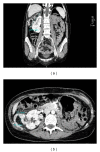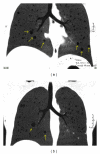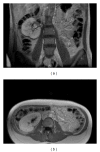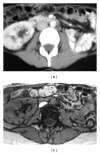Giant bilateral renal angiomyolipomas and lymphangioleiomyomatosis presenting after two successive pregnancies successfully treated with surgery and rapamycin
- PMID: 22125460
- PMCID: PMC3217590
- DOI: 10.1100/2011/263137
Giant bilateral renal angiomyolipomas and lymphangioleiomyomatosis presenting after two successive pregnancies successfully treated with surgery and rapamycin
Abstract
We report the case of a 25-year-old woman who presented with abdominal and flank pain with two successive pregnancies and was diagnosed of giant bilateral renal AMLs and pulmonary LAM associated with TSC in the post-partum of her second pregnancy. This case illustrates that in women with TSC rapid growth from renal AMLs and development of LAM may occur with successive pregnancies. It also stresses the potential for preservation of renal function despite successive bilateral renal surgery of giant AMLs. Moreover, the treatment with a low-dose rapamycin may be an option for LAM treatment. Finally, a low-dose rapamycin may be considered as an adjuvant treatment together to kidney-sparing conservative surgery for renal AMLs.
Keywords: Angiomyolipomas; lymphangioleiomyomatosis; mTOR; nephrectomy; pregnancy; tuberous sclerosis complex.
Figures




Similar articles
-
Giant Renal Angiomyolipomas and Pulmonary Lymphangioleiomyomatosis: Follow-up Report after More than a Decade.Saudi J Kidney Dis Transpl. 2023 Nov 1;34(6):671-675. doi: 10.4103/sjkdt.sjkdt_324_21. Epub 2024 May 9. Saudi J Kidney Dis Transpl. 2023. PMID: 38725217
-
Conservative management of pulmonary lymphangioleiomyomatosis and tuberous sclerosis complicated by renal angiomyolipomas in pregnancy.J Matern Fetal Neonatal Med. 2004 Feb;15(2):132-4. doi: 10.1080/14767050410001659879. J Matern Fetal Neonatal Med. 2004. PMID: 15209123
-
Giant renal angiomyolipomas and pulmonary lymphangiomyomatosis.Saudi J Kidney Dis Transpl. 2010 Mar;21(2):314-9. Saudi J Kidney Dis Transpl. 2010. PMID: 20228520
-
Lymphangioleiomyomatosis.Clin Chest Med. 2016 Sep;37(3):389-403. doi: 10.1016/j.ccm.2016.04.002. Clin Chest Med. 2016. PMID: 27514586 Review.
-
Renal angiomyolipoma and lymphangioleiomyomatosis in pregnancy.J Obstet Gynaecol. 2013 Aug;33(6):542-6. doi: 10.3109/01443615.2013.812622. J Obstet Gynaecol. 2013. PMID: 23919845 Review.
Cited by
-
The Risks of Renal Angiomyolipoma: Reviewing the Evidence.J Kidney Cancer VHL. 2017 Oct 16;4(4):13-25. doi: 10.15586/jkcvhl.2017.97. eCollection 2017. J Kidney Cancer VHL. 2017. PMID: 29090118 Free PMC article. Review.
-
Complications of lymphangioleiomyomatosis in pregnancy: a case report and review of the literature.AJOG Glob Rep. 2024 Jan 10;4(1):100309. doi: 10.1016/j.xagr.2024.100309. eCollection 2024 Feb. AJOG Glob Rep. 2024. PMID: 38327672 Free PMC article.
-
Familial genetic tuberous sclerosis complex associated with bilateral giant renal angiomyolipoma: A case report.Oncol Lett. 2017 Dec;14(6):7099-7106. doi: 10.3892/ol.2017.7165. Epub 2017 Oct 10. Oncol Lett. 2017. PMID: 29344140 Free PMC article.
-
Exacerbation and remission of pulmonary micronodules with lymphangioleiomyomatosis around the time of childbirth.Jpn J Radiol. 2013 Sep;31(9):633-6. doi: 10.1007/s11604-013-0221-9. Epub 2013 Jun 2. Jpn J Radiol. 2013. PMID: 23729367
-
The effect of pregnancy on renal angiomyolipoma; a world of knowledge to gain, specifically in women with TSC.BMC Nephrol. 2024 Mar 22;25(1):113. doi: 10.1186/s12882-024-03483-4. BMC Nephrol. 2024. PMID: 38519911 Free PMC article.
References
-
- Crino PB, Nathanson KL, Henske EP. Medical progress: the tuberous sclerosis complex. New England Journal of Medicine. 2006;355(13):1306–1356. - PubMed
-
- Mascarenhas R, McLaughlin P. Haemorrhage from angiomyolipoma of kidney during pregnancy—a diagnostic dilemma. Irish Medical Journal. 2001;94(3):84–85. - PubMed
-
- Fernández Arjona M, Mínguez R, Serrano P, et al. Rapidly-growing renal angiomyolipoma associated with pregnancy. Actas Urologicas Espanolas. 1994;18(7):755–757. - PubMed
-
- Koh JL, Lee YH, Kang CY, Lin CN. Simultaneous cesarean section and radical nephrectomy for angiomyolipoma with spontaneous bleeding during pregnancy: a case report. Journal of Reproductive Medicine for the Obstetrician and Gynecologist. 2007;52(4):338–340. - PubMed
-
- Raft J, Lalot J-M, Meistelman C, Longrois D. Influence of pregnancy on renal angiomyolipoma. Gynecologie Obstetrique Fertilite. 2005;33(11):898–906. - PubMed
Publication types
MeSH terms
Substances
LinkOut - more resources
Full Text Sources
Medical
Miscellaneous

